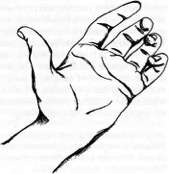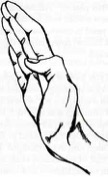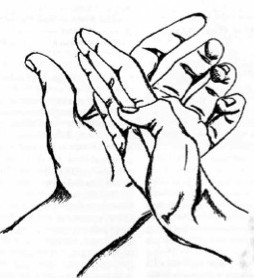On one occasion, when he was visiting his homeland among the Sakya clans, the Buddha is said to have given a significant discourse on the nature of exertion and striving. The context of the discussion was his criticism of the Jain ascetic practices, so common in ancient India, but his remarks on the subject are of immense importance to the contemporary practice of insight meditation.
And how is exertion fruitful, bhikkhus, how is striving fruitful? Here, bhikkhus, a bhikkhu is not overwhelmed by suffering and does not overwhelm himself with suffering; and he does not give up the pleasure that accords with Dhamma, yet he is not infatuated with that pleasure.
He knows thus: “When I strive with determination, this particular source of suffering fades away in me because of that determined striving; and when I look on with equanimity, this particular source of suffering fades away in me while I develop equanimity.”
He strives with determination in regard to that particular source of suffering which fades away in him because of that determined striving; and he develops equanimity in regard to that particular source of suffering which fades away in him while he is developing equanimity. When he strives with determination, such and such a source of suffering fades away in him because of that determined striving; thus that suffering is exhausted in him. When he looks on with equanimity, such and such a source of suffering fades away in him while he develops equanimity; thus that suffering is exhausted in him.
 This is the dilemma: If we “try” too hard to practice meditation, if we deliberately exert ourselves to “succeed” at the task, then we may tap into an entire complex of unwholesome conditioning so prevalent among Western students. “Striving mind” can be extremely counterproductive, unleashing a crippling self-judgment if we don’t match up to the goals we have set for ourselves. On the other hand, if we do not strive at all, and merely “go along” with whatever is arising in all situations, then we may simply drift to wherever the “monkey mind” happens to take us. Our underlying tendency to pursue pleasure and avoid pain, left to its own devices, can result in our mindfully avoiding any significant transformation.
This is the dilemma: If we “try” too hard to practice meditation, if we deliberately exert ourselves to “succeed” at the task, then we may tap into an entire complex of unwholesome conditioning so prevalent among Western students. “Striving mind” can be extremely counterproductive, unleashing a crippling self-judgment if we don’t match up to the goals we have set for ourselves. On the other hand, if we do not strive at all, and merely “go along” with whatever is arising in all situations, then we may simply drift to wherever the “monkey mind” happens to take us. Our underlying tendency to pursue pleasure and avoid pain, left to its own devices, can result in our mindfully avoiding any significant transformation.
The Buddha’s profound teaching of the middle way, applied particularly to the dynamics of meditation practice, is the theme of this passage from the Devadaha Sutta (Majjhima Nikāya 101). The point is finding the right balance between ” striving with determination” and “looking on with equanimity.” Neither approach is correct all the time, but each can be used as a skillful technique for addressing certain mental states. The two approaches complete one another.
“Striving with determination” (saṃkhāram padahato) can mean disciplining oneself in morality, as when one might want to cover up a misdeed by lying or one might want to consume something greedily. Through a certain strength of character or dedication to what we know to be right, we can sometimes determine to do the proper thing, even though it means the acceptance of certain difficulties (as in the former case) or the renunciation of certain immediate pleasures (as in the latter). But in a more delicate way, such determined striving is also what we do when we gently return the wandering mind to awareness of the breath during sitting practice. The practice of meditation differs from an hour of spacing out on a zafu precisely in this quality of recollecting to return our attention to a primary object—again and again as it inevitably drifts off.
“Looking on with equanimity” (ajjhupekkhato), in the context of meditation practice, refers to the nonjudgmental quality of open, choiceless awareness, so crucial to bring to whatever enters the field of experience. Equanimity is described in Buddhist literature as that quality of mind that is in equipoise—neither drawn to what entices nor shunning what is painful or disgusting, but balanced evenly amidst all phenomena. It is the perspective that allows us to open to the full spectrum of our experience—the pain in the knee as much as the songbird outside the meditation hall window, the beautiful thought of inspired insight as much as the ugly realization of personal shortcomings—while holding it all with a selfless, mindful awareness.
As this text says so clearly, there are certain sources of suffering that fade away by determined striving, and others that do so by looking on with equanimity. This is the example the Buddha gives to illustrate what he means by looking on with equanimity:
Suppose, bhikkhus, a man loved a woman with his mind bound to her by intense desire and passion. He might see that woman standing with another man, chatting, joking, and laughing. What do you think, bhikkhus? Would not sorrow, lamentation, pain, grief, and despair arise in that man when he sees that woman standing with another man, chatting, joking, and laughing?
“Yes, venerable sir. Why is that? Because that man loves that woman with his mind bound to her by intense desire and passion….”
Then, bhikkhus, that man might think: “What if I were to abandon my desire and lust for that woman?” He would abandon his desire and lust for that woman.
On a later occasion he might see that woman standing with another man, chatting, joking and laughing. What do you think bhikkhus? Would sorrow, lamentation, pain, grief, and despair arise in that man when he sees that woman standing with another man?
“No, venerable sir. Why is that? Because that man has no attachment to that woman.”
 Whether or not we would all find it quite so easy to simply abandon desire for a person we loved (or, as the story more precisely describes, a person with whom we were possessively infatuated), the point is that we look upon something very differently when we look with desire and with equanimity. Sometimes, the bonds of grasping are best loosened by this gentle technique of simple nonattachment. On the meditation cushion this is manifest as treating no arising object as more dear than another, but observing all phenomena with equal interest.
Whether or not we would all find it quite so easy to simply abandon desire for a person we loved (or, as the story more precisely describes, a person with whom we were possessively infatuated), the point is that we look upon something very differently when we look with desire and with equanimity. Sometimes, the bonds of grasping are best loosened by this gentle technique of simple nonattachment. On the meditation cushion this is manifest as treating no arising object as more dear than another, but observing all phenomena with equal interest.
The story told in this sutta about striving with determination is put in the language of turning away from what is pleasurable, even if it means temporarily opening up to what is painful. The point is that while this may seem difficult at first, it becomes easier as one become habituated to it, until it is no longer painful at all.
Again, bhikkhus, a bhikkhu considers thus: “While I live according to my pleasure, unwholesome states increase in me and wholesome states diminish; but when I exert myself in what is painful, unwholesome states diminish in me and wholesome states increase. What if I exert myself in what is painful?” He exerts himself in what is painful. When he does so, unwholesome states diminish in him and wholesome states increase.
At a later time he does not exert himself in what is painful. Why is that? The purpose for which that bhikkhu exerted himself in what is painful has been achieved.
Suppose, bhikkhus, an arrowsmith were warming and heating an arrow shaft between two flames, making it straight and workable. When the arrow shaft had been warmed and heated between the two flames and had been made straight and workable, then at a later time he would not again warm and heat the arrow shaft and make it straight and workable. Why is that? The purpose for which that arrowsmith had warmed and heated the arrow and made it straight and workable has been achieved.
Our mind may find pleasure in pursuing its whimsical trains of thought into one story after another; and indeed it is the very pursuit of pleasurable experience that leads the mind’s meandering. At first it may feel like a chore to retrieve the mind from its excursions and return it to the primary object of attention, but as we practice this we gradually get used to it and it can in fact become a most rewarding habit. This is just one example of how striving with determination, though interventionist in the short run, can before long lead to very beneficial results.
Balance is the key. As we’re told in the Upakkilesa Sutta (M128), grasp a quail too tightly and it will die then and there; but grasp the quail too loosely and it will fly out of your hands. Or, as in the metaphor of the lute string told by the Buddha to the monk Sona (A6.55), neither too much striving nor too much acquiescence is as effective as tuning our method carefully to bring the factor of effort (viriya) into perfect harmony with the moment.

I follow the translation of Bhikkhus Nanamoli and Bodhi in The Middle Length Discourses of the Buddha, Wisdom Publications, Boston (1995), with some minor changes to the end of the 2nd passage.